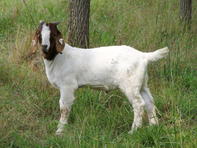Most of the world’s 570 goat breeds in the world were developed from three types of goats - the Bezoar, Savannah and Nubian goat types. The development of the Boer goat, however, is unique as it did not follow the crossbreeding of two or more pure breeds.

Instead, the Boer goat’s ancestors were selected from indigenous goat breeds in South Africa and developed in the 1950s by a group of farmers in the Somerset East district of the Eastern Cape Province in South Africa.
Research on meat goat farming is negligible compared to that of other species of meat producing livestock, yet South Africa has gained international recognition for its work on the development of the Boer goat breed.
During the same time as the development of the Boer goat research by Devendra and Burns (1983) was done on East African indigenous goats. This demonstrated the huge potential of these hardy small ruminants in terms of efficient meat production.
Meat Goats Breeds in South Africa
The main meat goat breed is the Boer goat, considered the best meat goat breed in the world. It has the best feed-to-meat conversion rate. The breed shows excellent growth traits, meat and carcass characteristics with yields often exceeding 50%.
The other two main meat goat breeds in South Africa are the Kalahari Red and the Savanna, also considered ‘Boer goats’ but with specific colouring. DNA tests showed there is a bigger genetic difference between the Boer and the Kalahari Red than the Boer and the Savanna goats. The Kalahari Red is regarded as an indigenous goat breed originating from Southern Africa.
Records indicate that the goats have been selected from lop-eared animals that migrated with tribes to the southern part of Africa more than 2000 years ago. The 100% red colour of the skin provides camouflage from predators in the wild and they are hardy, resistant to heat and drought.
The white Savanna goat was developed in 1955 and is considered a drought-resistant breed that yields a lean balanced carcass. They are very adaptable and can be used successfully on intensive pastures as well as in extensive grazing systems. They are not seasonal breeders.
Savanna wethers (castrated rams) have a good growth rate and are an early- to medium-maturity type. Savanna goats produce carcasses with good conformation - the thickness of muscle and fat in relation to the bone structure.
Indigenous Goats
There are four eco-types (subspecies) of indigenous goats in South Africa - the Nguni type (Mbuzi), Eastern Cape Xhosa Lob-ear, Northern Cape Speckled and the Kunene type (Kaokoland).
Indigenous goats are more drought resistant and hardy than Boer goats and less susceptible to heartwater, a serious tick-borne disease.
A study by Ramsay, Smit & Casey (1987) compared the indigenous goat vs the Boer goat in environments where protozoal diseases, foot rot, parasites and toxic plants were limiting factors.
The goats were all recorded and evaluated on the National Scheme and the data showed that the indigenous goat produced more meat per unit area than Boer goats. Most indigenous goats are traded in the informal sector and slaughtered in a traditional way.
The Tankwa Goat
The recently discovered Tankwa goat is in the process of being registered as a landrace goat breed with South Africa’s Department of Agriculture, Forestry and Fisheries (DAFF).
According to Thinus Jonker of the Northern Cape department of agriculture, the Tankwa shows great potential as a meat goat. While not showing the same carcass characteristics as the three Boer goat breeds, their strong points - parasite and disease resistance, fertility and excellency mothering - could be enhanced with inbreeding.
Angora Goat as Meat Goat
When the mohair fibre of older Angora goats becomes too rough, the goats are selected for culling. About 90% of these older goats are sent KwaZulu-Natal to be sold for the traditional market. It attains a better price (live weight) than selling the meat via a commercial abattoir.
The carcass-to-meat ratio is, however, very low - only 30 - 35% compared to around 50% for Boer goats - but the texture of the meat is much finer than that of Boer goats. Compared to Boer goats (22.8%) and indigenous goats (24.3%), Angora has the highest protein content (29.1%). Angora meat also has the least amount of fat (4.4%) compared to 10.5% (Boer goat meat) and 7.9% (indigenous goat meat).
By Marinda Louw